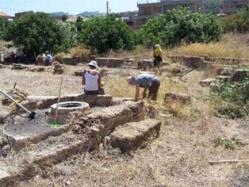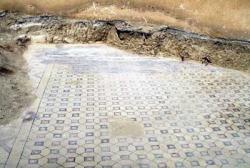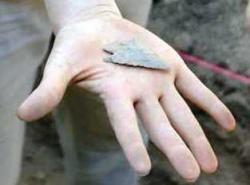- 24 - 25 SEPTEMBRE
- INDI-UNI : ANTHROPOLOGY - ARCHAEOLOGY
REGISTRATION 2011 – 2012 ONLINE COURSES
INSCRIPTION 2011 – 2012 COURS A DISTANCE
FRANCE – Banville - Découvert au XIX e siècle par Arcisse de Caumont, le site archéologique de la Burette continue de livrer ses secrets. L'éperon qui borde la vallée de la Seulles fait l'objet d'une troisième campagne de fouilles, après 2005 et 2007, sous la direction, à nouveau, de Gwénolé Kerdivel, docteur en archéologie, à l'université de Rennes. « Nous travaillons sur un site du néolithique moyen, soit 4 500 à 3 500 ans avant notre ère, attenant à un site de l'Âge du fer, soit 500 à 400 ans, avant notre ère, indique Gwénolé Kerdivel. Nous avons recueilli suffisamment d'éléments de la vie quotidienne pour affirmer que nous sommes sur l'emplacement d'un village néolithique. » Un minutieux travail de fourmi a permis de mettre à jour de véritables trésors : fragments de céramique, silex taillés, ossements d'animaux et même graines brûlées. De précieux indicateurs pour comprendre les pratiques alimentaires de nos ancêtres. Mais il semblerait que la trouvaille la plus intéressante réside dans le plan d'une mystérieuse maison. « C'est la chose qui pose le plus de questions, avance Gwénolé Kerdivel. La maison ne peut pas être de l'époque gauloise car elle livre du mobilier néolithique. Si elle s'avérait une maison néolithique, la découverte serait importante. Ce serait seulement la deuxième identifiée dans le nord de la France. » Étrange coïncidence : la première vient d'être trouvée, le mois dernier, dans l'Orne. « Seul le radiocarbone permettra d'établir une datation. » Le néolithicien breton s'apprête à mettre un terme à l'exploration du site. « Une grosse partie n'a plus besoin d'être fouillée. Nous allons remettre les matériaux collectés dans le contexte du néolithique. Il nous restera à comprendre la chronologie et l'organisation de cette concentration de fosses et de structures. »
http://www.ouest-france.fr/actu/actuLocale_-Ouverture-au-public-du-chantier-de-fouilles-archeologiques-_14355-avd-20110917-61287974_actuLocale.Htm
- ALGERIE –  Kef Dahmouni - Une dizaine de personnes, formant une équipe d’archéologues du centre national de recherches préhistoriques, anthropologiques et historiques, entreprend, depuis une dizaine de jours, des travaux de recherches sur la géo-localisation et les fouilles, après le travail exploratoire entrepris par Robert Cadenat dans son fameux Atlas dans les années 1940. Tiaret regorge de sites où l’on invoque le paléolithique et le néolithique pour percer les secrets entourant la vie d’une cité millénaire où plusieurs civilisations se sont succédé, laissant derrière elles des restes à circonscrire aux lieux et à dater. Les traces de l’homme du quaternaire et de l’homo-sapiens remontent à 8000 ans avant Jésus-Christ. Ces stations préhistoriques constituent aujourd’hui des sites touristiques à haute valeur scientifique et archéologique rehaussées par la présence de gravures rupestres.
Kef Dahmouni - Une dizaine de personnes, formant une équipe d’archéologues du centre national de recherches préhistoriques, anthropologiques et historiques, entreprend, depuis une dizaine de jours, des travaux de recherches sur la géo-localisation et les fouilles, après le travail exploratoire entrepris par Robert Cadenat dans son fameux Atlas dans les années 1940. Tiaret regorge de sites où l’on invoque le paléolithique et le néolithique pour percer les secrets entourant la vie d’une cité millénaire où plusieurs civilisations se sont succédé, laissant derrière elles des restes à circonscrire aux lieux et à dater. Les traces de l’homme du quaternaire et de l’homo-sapiens remontent à 8000 ans avant Jésus-Christ. Ces stations préhistoriques constituent aujourd’hui des sites touristiques à haute valeur scientifique et archéologique rehaussées par la présence de gravures rupestres.
http://www.elwatan.com/regions/ouest/tiaret/archeologie-une-equipe-du-cnrpah-en-mission-d-exploration-a-kef-dahmouni-25-09-2011-140970_136.php
- TURQUIE – Perge - La moitié supérieure de l’Heraclès Fatigué, une sculpture du IIe siècle provenant de Perge sortie illégalement de Turquie, se voit rendue par le Musée des beaux-arts de Boston. Elle ira au musée d’Antalya. Le Museum of Fine Arts de Boston indique sur son site avoir acheté la partie supérieure de la statue en marbre en 1981 à un particulier, résidant en Allemagne. Ce dernier affirmait que sa famille avait acquis l’objet auprès d’un marchand germanique. En 1990, un universitaire a remarqué la similitude entre la partie haute de la statue, comprenant une tête et un torse, et le bas, soit deux jambes, un ventre et un bras, exhumé en 1980 à Perge et aujourd’hui exposés au Musée archéologique. On pense à On a volé la cuisse de Jupiter , une comédie de Philippe de Broca réalisée en 1980avec Philippe Noiret et Annie Girardot. Le film racontait la même histoire.
http://www.tdg.ch/hercule-fatigue-turc-retrouve-tete-americaine-2011-09-25
- SYRIE –  Hwaija Halawa - The national archeological expedition working in Hwaija Halawa site on the banks of al-Assad Lake in Raqqa governorate uncovered a massive rectangular mosaic dating back to the 6th century AD. So far, the expedition uncovered 58 square meters of the mosaic, and work is underway to uncover the rest during the coming few days. The mosaic consists of various interlocking geometric shapes made with white, black and red tiles. Al-Jirniye, the area in which the site is located, contains many important archeological sites, most notable of which is Tel al-Mbraibet site where one of the oldest human residence in history was found.
Hwaija Halawa - The national archeological expedition working in Hwaija Halawa site on the banks of al-Assad Lake in Raqqa governorate uncovered a massive rectangular mosaic dating back to the 6th century AD. So far, the expedition uncovered 58 square meters of the mosaic, and work is underway to uncover the rest during the coming few days. The mosaic consists of various interlocking geometric shapes made with white, black and red tiles. Al-Jirniye, the area in which the site is located, contains many important archeological sites, most notable of which is Tel al-Mbraibet site where one of the oldest human residence in history was found.
http://www.sana.sy/gallery.html?gid=488&newlang=eng
- INDE – Mumbai - The Banganga tank, one of the oldest heritage precincts located in the heart of Mumbai, and presently in a battered situation, is soon to get a facelift. With mossy green broken steps, chipped walls, defaced deepstambhas surrounded by encroachments and the water tank whose natural water springs are blocked, the 600-year-old structure if far from what it represents — a tributary of the Ganges.
http://www.hindustantimes.com/Banganga-to-get-Rs-5-5-cr-facelift/Article1-749870.aspx
- INDE - Fategharh Churian - Precious frescos of Panj Temple in Fategharh Churian, which have immense heritage value and date back 180 years, are blissfully being whitewashed out of ignorance even as the Archaeological Survey of India (ASI), that has already documented the historical shrine, is yet to swing into action to preserve the treasure.To one's utter dismay, the 14 metal idols of Hindu deities, which were certified for antiquities by the state department of Cultural Affairs Archaeology & Museums, have also done a vanishing act in the past 11 years. A sneak peek into its history will reveal that the temple was built by the daughter-in-law of Sikh ruler Maharaja Ranjit Singh, Chand Kaur of Kanahaiya Misil, who put the Hindu deities on a high pedestal and used to worship in the temple every day. The temple also has paintings of Guru Nanak Dev with his two disciples Bala and Mardana. Some of the idols are of Laddu Gopal, Garur Bell, Goddess Durga, Lord Krishna and His consort Radha. The wall paintings depict Lord Krishna seated on Kalia serpent and the tale of Matasya Avtar. The sanctum sanctorum of the temple has idols of Lord Krishna and Goddess Vaishno Devi while the four other shrines constructed on all four corners have idols of Lord Ganesh, Lord Shiva, Lord Kartikae and Surya Dev on a common floor made of Nanakshahi bricks. Many frescos have been recklessly whitewashed and due to carelessness many portions of the walls lie broken and their plaster has peeled off. New constructions have been made further squeezing the temple space.
http://timesofindia.indiatimes.com/city/chandigarh/Heritage-whitewashed-in-Fatehgarh-Churian/articleshow/10109546.cms
- USA –  Mendocino - For a week, 32 volunteers, 11 archaeologists and two tribal representatives from Round Valley lived on the Mendocino National Forest to work on a Passport in Time (PIT) archaeology project. The project participants were working on sample excavations across a site believed to be a prehistoric hunting base camp. Findings included stone flakes from making and maintaining projectile points, partial and nearly whole projectile points, as well as other stone tools. Projectile points are mostly large specimens used on spears, rather than associated with bow and arrow, a technology that came later in time. “It’s kind of unusual at this elevation to find a lot of ground stone – we’re at 6,200 plus feet,” said Forest Archaeologist Mike Dugas. “There are quite a few pieces including a small pestle, an anvil stone and various milling stone fragments typically used for processing plant foods. These implements suggest families were at the site, as plant processing was typically done by women.” Most projectile points found at the site appear to be 3,000 to 5,000 years old, according to the archaeologists. “The early component is most likely representative of the Yuki tribal territory,” Dugas said. “The presence of artifacts which appear to be made from northeast obsidian sources suggest the Nomlaki were here at some point also. Obsidian analysis will tell us more about who and when the site was occupied. The bulk of tools we’re finding here are from the early period.”
Mendocino - For a week, 32 volunteers, 11 archaeologists and two tribal representatives from Round Valley lived on the Mendocino National Forest to work on a Passport in Time (PIT) archaeology project. The project participants were working on sample excavations across a site believed to be a prehistoric hunting base camp. Findings included stone flakes from making and maintaining projectile points, partial and nearly whole projectile points, as well as other stone tools. Projectile points are mostly large specimens used on spears, rather than associated with bow and arrow, a technology that came later in time. “It’s kind of unusual at this elevation to find a lot of ground stone – we’re at 6,200 plus feet,” said Forest Archaeologist Mike Dugas. “There are quite a few pieces including a small pestle, an anvil stone and various milling stone fragments typically used for processing plant foods. These implements suggest families were at the site, as plant processing was typically done by women.” Most projectile points found at the site appear to be 3,000 to 5,000 years old, according to the archaeologists. “The early component is most likely representative of the Yuki tribal territory,” Dugas said. “The presence of artifacts which appear to be made from northeast obsidian sources suggest the Nomlaki were here at some point also. Obsidian analysis will tell us more about who and when the site was occupied. The bulk of tools we’re finding here are from the early period.”
http://lakeconews.com/content/view/21568/919/